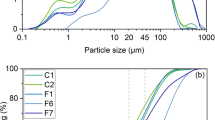Fly ash produced from burning pulverized coal mainly consists of solid amorphous aluminosilicate spheres, which, with the exception of small particles, determine its erosive properties. Erosive wear and properties of the particles depend to a large extent on external conditions, and specifically, on fuel preparation and combustion. As far as the experimental data on conventional pulverized coal combustion of hard and brown 3B coals are concerned, the acidic-to-basic component ratio has the best statistical characteristics for predicting the erosion coefficient. There are no available data on the erosive properties of fly ash when implementing combustion measures to reduce nitrous oxides.
Similar content being viewed by others
References
State Standard GOST 21708–96. Solid Mineral Fuel. Method for Determination of Ash Abrasiveness Coefficient [in Russian], IPK Izd. Standartov, Moscow (1997).
M. Suckling, High Temperature Erosive Wear of a Boiler Tube Steel. Ph.D. Thesis, University of Cape Town, SAR (1996).
State Standard GOST 30827–2002. Solid Mineral Fuel. Determination of Abrasiveness [in Russian], IPK Izd. Standartov, Moscow (2003).
P 09–83. Recommendations for Calculating the Abrasive Wear of Slurry Pipelines and Pumps of the TPP Hydraulic Ash-transport Systems [in Russian], Izd. VNIIG, Leningrad (1983).
Thermal Calculation of the Boiler Units (standard method) [in Russian], NPO TsKTI (1998).
RD 153-34.1-26.519–98. Guidelines for Optimizing the Designs of Finned Economizers and their Ash Protection Devices [in Russian], SPO ORGRÉS, Moscow (2000).
RD 153-34.1-27.512-2001. Calculation Guidelines and Recommendations for Reducing Abrasive Wear of Pneumatic Transport Pipelines of the Pulverized Coal and Ash Removal Systems [in Russian].
D. J. Foster, W. R. Livingston, J. Wells, et al., Particle Impact Erosion and Abrasion Wear Predictive Methods and Remedial Measures, Report No. COAL R241, DTI, Pub URN 04/701, Mitsui Babcock Energy Limited (2004).
A. V. Levy and P. Chik, The Effects of Erodent Composition and Shape on the Erosion of Steel, LBL-15242, University of California, CA, USA (1982).
E. Raask, Erosion Wear in Coal Utilization, Hemisphere Publishing Corp., Washington (1988).
D. de Lima Gomes, B. R. Cardoso, H. C Furtado, and M. G. Diniz, “Characterization of fly ash and a protective coating for Brazilian thermal power plant boilers,” Mat. Res. Brazil, 23, 6 (2020).
B. E. Lee, Computational Prediction of Deposition and Erosion in Boiler Tube Banks. Ph.D. Thesis, University of New South Wales, Sydney, Australia (1997).
P. Venturini, A. Corsini, F. Rispoli, and A. G. Sheard, “Numerical simulation of coal fly ash erosion in an induced draft fan,” J. Fluids Eng., 135, 081303-1 – 081303-12 (2013).
Y. Jin, G.-H. Tang, Y.-L. He, and W.-Q. Tao, “Numerical study of the solid particle erosion on H-type finned circular/elliptic tube surface,” Commun. Comput. Phys., 21(2), 466 – 489 (2017).
Thermal Calculation of the Boiler Units (standard method) [in Russian], Énergiya, Moscow (1973).
R. D. Shandu, Experimental Investigation of Erosion Caused by Gas-Borne Ash Particles. Master’s Thesis, University of the Witwatersrand, Johannesburg, SAR (2007).
M. I. Vdovenko, A. Ya. Bayakhunov, and N. Ya. Chursina, Contamination and Wear of the Boiler Heating Surfaces [in Russian], Nauka, Alma-Ata (1978).
N. A. Zroichikov, V. Ya. Putilov, I. V. Putilova, S. A. Fadeev, and Ye. A. Malikova, “Assessment of the effect of abrasive wear on the service life of hydraulic pipelines of the TPP ash removal systems,” Teploénergetika, No. 9, 35 – 45 (2020).
V. V. Zyryanov and D. V. Zyryanov, Pulverized Fuel Ash — a Man-Made Raw Material [in Russian], Izd. Maska, Moscow (2009).
A. N. Alekhnovich, Ash and Slagging in Pulverized Coal Boilers [in Russian], Tsitsero, Chelyabinsk (2016).
L. Ya. Scryabina, Atlas of Industrial Dusts, Part I. Fly Ash of Thermal Power Plants [in Russian], TsINTIKhIMNEFTEMASh, Moscow (1980).
M. I. Birger, A. Yu. Valdberg, B. I. Myagkov, et al., Handbook on Dust and Ash Collection [in Russian], Énergoatomizdat, Moscow (1983).
S. K. Das, K. M. Godiwalla, S. P. Mehrotra, K. M. Sastry, and P. K. Dey, “Analytical model for erosion behavior of impacted fly-ash particles on coal-fired boiler components,” Sadhana, 31(Part 5), 583 – 595 (2006).
M. T. Karimov, M. V. Yermolenko, O. A. Stepanova, and M. Zh. Baizhumanov, “Effect of the fractional composition of ash on the abrasive wear of heating surfaces of power boilers,” Mezhdunar. Zh. Prikl. Fund. Issl., No. 4 – 3, 532 – 535 (2016).
J. Singh, S. Kumar, and S. K. Mohapatra, “Study of the role of particle shape in erosion wear of austenitic steel using image processing analysis technique,” Proc. Inst. Mech. Eng. Part J. J. Eng. Tribol., 233, 5 (2019).
Yu. A. Dolbnya and M. Ya. Protsailo, “On the dependence of abrasive properties of ash on its composition,” Énergetik, No. 7, 31 (1983).
V. P. Yatsenko, O. A. Shraiber, A. O. Troynyak, and I. Yu. Tokarev, “Engineering procedure for calculating abrasive wear of the boiler heating surfaces,” Probl. Zagal. Énerg., No. 20, 40 – 44 (2009).
N. P. Gerasimova and N. Ye. Buinov, “Assessment of abrasive wear of the convective heating surfaces of the boiler units,” Vestn. Irkutsk. Gos. Tekhn. Univ., No. 7, 117 – 120 (2011).
A. N. Alekhnovich, Characteristics and Properties of Power- Generating Coals [in Russian], Tsitsero, Chelyabinsk (2012).
G. P. Huffman, F. E. Huggins, and G. R. Dunmyre, “Investigation of the high-temperature behavior of coal ash in reducing and oxidizing atmospheres,” Fuel, 60, 585 – 597 (1981).
V. S. Vdovchenko, M. I. Martynova, N. V. Novitskii, and G. D. Yushina, USSR Energy Fuels (fossil coals, oil shale, peat, fuel oil, combustible gas). Reference Book [in Russian], Énergoatomizdat, Moscow (1991).
Author information
Authors and Affiliations
Corresponding author
Additional information
Translated from Élektricheskie Stantsii, No. 3, March 2021, pp. 2 – 10. DOI: 10.34831/EP.2021.1076.3.001
Rights and permissions
About this article
Cite this article
Alekhnovich, A.N. Erosive Properties of Pulverized Coal Fly Ash (Review). Power Technol Eng 55, 396–403 (2021). https://doi.org/10.1007/s10749-021-01372-6
Published:
Issue Date:
DOI: https://doi.org/10.1007/s10749-021-01372-6



